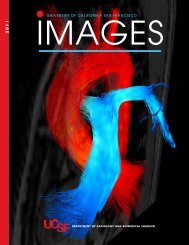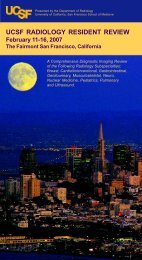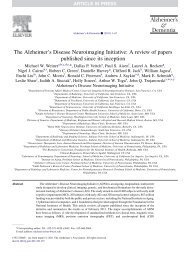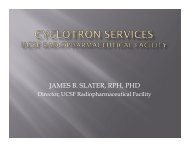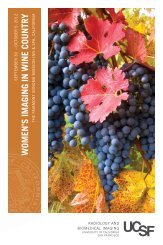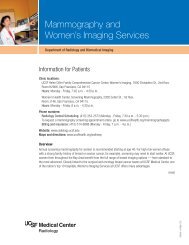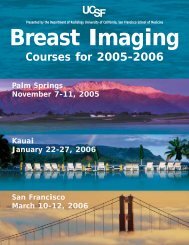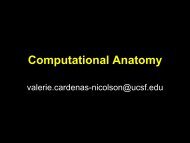6th International Workshop on Breast Densitometry and Breast ...
6th International Workshop on Breast Densitometry and Breast ...
6th International Workshop on Breast Densitometry and Breast ...
- No tags were found...
Create successful ePaper yourself
Turn your PDF publications into a flip-book with our unique Google optimized e-Paper software.
P43<br />
6 th <str<strong>on</strong>g>Internati<strong>on</strong>al</str<strong>on</strong>g> <str<strong>on</strong>g>Workshop</str<strong>on</strong>g> <strong>on</strong> <strong>Breast</strong> <strong>Densitometry</strong><br />
<strong>and</strong> <strong>Breast</strong> Cancer Risk Assessment<br />
VISUAL ANALOGUE SCALE ASSESSMENT OF PERCENTAGE BREAST DENSITY: A<br />
STUDY OF AGREEMENT BETWEEN OBSERVERS AND WITH INTERACTIVE<br />
THRESHOLDING<br />
Jamie C. Sergeant 1 , Mary Wils<strong>on</strong> 2 , Nicky Barr 2 , Ursula Beetles 2 , Caroline Boggis 2 , Sara Bundred 2 , Megan<br />
Bydder 2 , Soujanya Gadde 2 , Emma Hurley 2 , Anil Jain 2 , Yit Lim 2 , Liz Lord 2 , Valerie Reece 2 , D. Gareth<br />
Evans 2 , Anth<strong>on</strong>y Howell 2 , Susan M. Astley 1<br />
1 Centre for Imaging Sciences, Institute for Populati<strong>on</strong> Health, University of Manchester, Manchester, UK:<br />
2 Nightingale Centre <strong>and</strong> Genesis Preventi<strong>on</strong> Centre, University Hospital of South Manchester,<br />
Manchester, UK<br />
Aim: The measurement of percentage breast density <strong>on</strong> a visual analogue scale (VAS) has been shown to<br />
have an associati<strong>on</strong> with breast cancer risk comparable to that of interactive thresholding software such as<br />
Cumulus (Sunnybrook Health Sciences Centre, Tor<strong>on</strong>to, Canada). While interactive thresholding is too<br />
labour intensive to implement in a breast screening programme for the purposes of prospective risk<br />
estimati<strong>on</strong>, the quick <strong>and</strong> simple VAS method is more well-suited to this applicati<strong>on</strong>. However, for VAS<br />
density measurement to be satisfactorily used for this purpose, there must be comparability between<br />
estimates produced by different observers. We examine the agreement between a group of observers<br />
assessing VAS breast density <strong>and</strong> their agreement with Cumulus.<br />
Method: 120 screening cases were sampled from the Predicting Risk Of Cancer At Screening<br />
(PROCAS) study, a large clinical study based in Manchester, UK, which aims to predict the risk of breast<br />
cancer when women attend routine breast screening. The cases all had Full-Field Digital Mammography<br />
(FFDM) images acquired <strong>on</strong> GE Senographe Essential equipment. The breast density of the cases was<br />
independently assessed by 12 experienced mammographic readers using a separate VAS for each<br />
radiographic projecti<strong>on</strong> (craniocaudal <strong>and</strong> mediolateral oblique) of both breasts. In additi<strong>on</strong>, a trained <strong>and</strong><br />
validated Cumulus user also estimated the density for each image. Assessment of inter-observer<br />
agreement <strong>and</strong> agreement with Cumulus was performed using the Bl<strong>and</strong>-Altman limits of agreement<br />
approach <strong>and</strong> the c<strong>on</strong>cordance correlati<strong>on</strong> coefficient (CCC). All density estimates were also discretised<br />
to the four BI-RADS breast compositi<strong>on</strong> categories <strong>and</strong> agreement <strong>on</strong> this ordinal scale measured with<br />
Cohen’s weighted kappa.<br />
Results: The maximum observed difference between estimates by two readers assessing the same case<br />
was 67.75 percentage points, while the mean difference between pairs of readers ranged from 0.76 to<br />
28.58 percentage points <strong>and</strong> the mean difference from Cumulus ranged from 0.38 to 22.98 percentage<br />
points. 95% limits of agreement between reader pairs, between which 95% of differences are expected to<br />
lie, were (-6.96, 18.62) at their narrowest <strong>and</strong> (-59.13, 1.97) at their widest, while between readers <strong>and</strong><br />
Cumulus they ranged from (-32.55, -3.29) to (-49.71, 3.94). Pairwise CCC values ranged from 0.44 to<br />
0.92, while the overall CCC across the 12 readers was 0.70. C<strong>on</strong>cordance with Cumulus ranged from 0.48<br />
to 0.87. Pairwise kappa values for the BI-RADS classificati<strong>on</strong> ranged from 0.37 to 0.84 for the 12 readers,<br />
with a mean of 0.66. Kappa values between the readers <strong>and</strong> Cumulus ranged from 0.40 to 0.80.<br />
ABSTRACTS<br />
C<strong>on</strong>clusi<strong>on</strong>: A lack of agreement was found between the readers visually assessing breast density <strong>and</strong> a<br />
comparable lack of agreement was also found between the readers <strong>and</strong> Cumulus. This group of readers<br />
had varying levels of experience of VAS breast density assessment, but were all routinely performing<br />
estimati<strong>on</strong> in the PROCAS study. The current study suggests that for VAS density to be used for risk<br />
stratificati<strong>on</strong> <strong>and</strong> pers<strong>on</strong>alised screening, inter-observer variati<strong>on</strong> must be accounted for, either through<br />
st<strong>and</strong>ardised training or by applying a correcti<strong>on</strong> to results after reading has been performed.<br />
78



